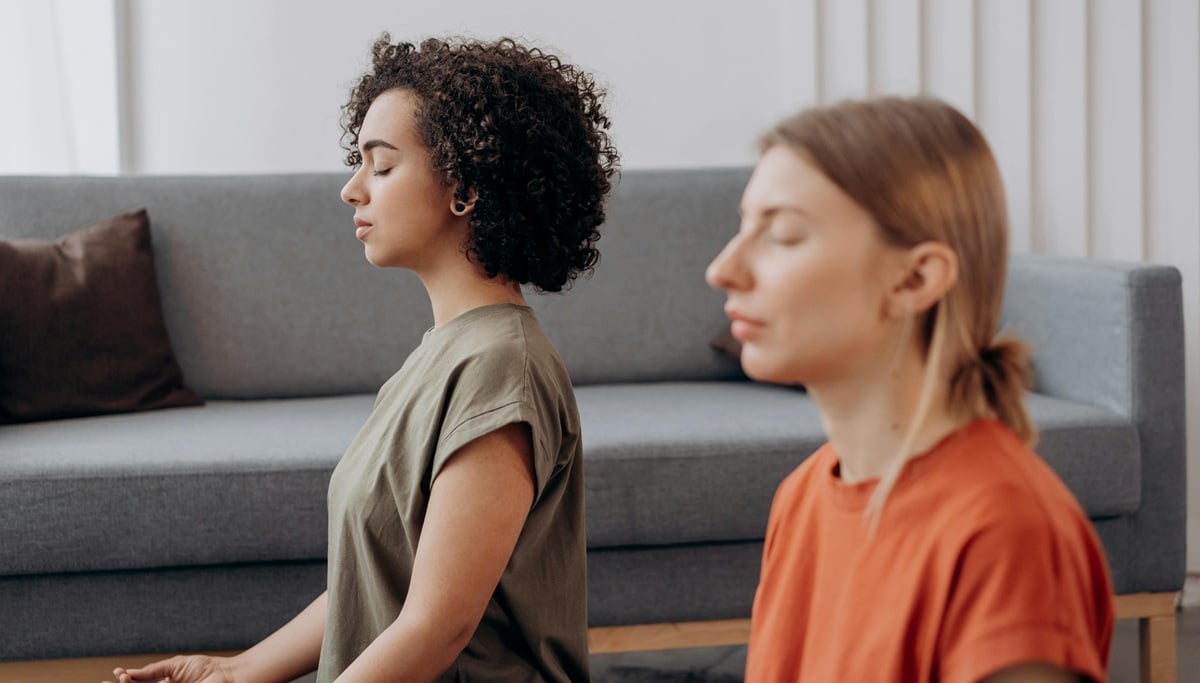Do you want to teach others to meditate? By following these pro tips, you can help people find peace during these challenging times.

Talking with other behavioral health professionals, I’ve found a common thread of clients who could benefit from the tranquility found in meditation. So, I’ve been working on a training that I’ll be delivering at the agency where I work. This isn’t exactly a training on how to meditate, but rather a training on how to teach meditation to others.
A Caveat
This will be an unusual blog post for me, but it could be helpful for you if you’re interested in teaching others to meditate. One caveat—this is oversimplified. It avoids a lot of jargon and doesn’t consider the years of practice that some meditation teachers (including myself) may have. This is originally a training for case managers, to give them some tools for introducing meditation to clients, even if the case managers themselves aren’t meditators. However, the training can be adapted to any personal or professional relationship.
So, it’s for beginners who want to learn meditation, and for beginners who want to teach meditation. So, here goes…
Teaching Meditation to Others
Often, we talk with those who discuss their stress, anxiety, and worry. They may express a need to supplement medications they are taking for these symptoms. Or they may be looking for a drug-free coping mechanism to help with their anxiety. Studies prove the benefits of meditation for physical and mental health. By listening to people’s expressed needs, you might find the right moment to ask if they have ever tried, or are interested in, meditation.
Many have tried meditation in various forms but have found it unhelpful. This is likely because they have either tried a type of meditation that does not fit their personality type. Or, they may have experienced roadblocks in meditation and lacked proper coaching to overcome these obstacles. This training will help you recommend and teach meditation to others and address possible roadblocks to meditation.
Common Concerns about Meditation
The following are concerns you might hear from those who feel uncomfortable with the idea of meditation. I also provide reassurances to correct misconceptions and put people’s minds at ease.
“I don’t have time to meditate.”
- By creating space for meditation in your life, you find your head is clearer and your emotions are more grounded. You become a more intentional person, and you find you have more time because of that intentionality. Besides this, thequality of your time is better.
“I’m not good at sitting still / clearing my mind.”
- Some forms of meditation involve sitting still. Others are more active. Some involve active thought, and others are more about clearing the mind. You can find the type of meditation that suits your personality, physical needs, and the needs of your day.
“I’m concerned it might violate my religion.”
- Every religion has a form of meditation. Meditation is a universal, human practice, and does not need to be religious at all. If you are concerned, then you can investigate the types of meditation practiced within your own tradition.
Four Types of Meditation
If someone says they are interested in learning meditation, you might ask whether they are the type of person who wants to move around (or has a hard time sitting still), or whether they would benefit from seated meditation (because they’re good at sitting still, or because of medical necessity). This training divides meditation into four types, which can overlap.
Physically Active Meditations
Some people meditate best when they can move around. They feel stifled or stiff when asked to sit for extended periods of time. Physically active meditations are best for these people.
Primary Example: Walking Meditation
- Who: This meditation is good for people who want to be alert and move. Primarily good for extroverts.
- Why: This meditation keeps a person active and promotes good health. It allows the person to change their scenery.
- Where: You can do this meditation as you walk through your neighborhood, in a shopping mall, or even from room to room in your house.
- How: Walk slowly, soaking in all the sights and sounds around you, as if you are seeing them for the first time. Develop a rhythm between your breaths and your footsteps. For example, four footsteps for each inhale and four footsteps for each exhale. Maintain that rhythm as you continue to walk. Notice how the rhythm changes if you are walking uphill, for example, four footsteps per inhale and three footsteps per exhale. Notice how it might change if you walk faster or jog, for example, three footsteps per inhale and two footsteps per exhale. For variety, try going very slowly, taking one step per inhale and another step per exhale. Be aware of everything that’s part of you—the sound of your breathing, the beat of your heart, the feeling of your feet on the ground, your core temperature rising as you get moving. Be aware of everything that’s around you—use all five senses to heighten your awareness. Be completely present in the moment. This presence and awareness is called Mindfulness. Mindfulness meditation can be done in any physically active meditation.
Other Examples of Physically Active Meditation
- Biking, swimming, any activity that involves repetitive movement that can be counted along with breaths.
- Non-repetitive movements that can also involve mindfulness meditation are gardening, cleaning, painting, sculpting, etc. The goal is to be totally present while doing these things.
Roadblocks in Physically Active Meditation
- “I’m not athletic—this kind of movement hurts.”
- If it hurts when you do that, don’t do that. Meditation shouldn’t be painful.
- “I get distracted by all the things around me.”
- Maybe you need a physically passive meditation where you can isolate yourself by closing your eyes.
- Try headphones or earplugs if sounds distract you.
- The goal of physically active meditation is generally NOT to block everything out, but to embrace everything, and experience it to the full. It is to find peace in activity.
Physically Passive Meditations
Some people meditate best when they are not distracted by physical movement. Others experience physical differences that make movement difficult. For these individuals, physically passive meditations are best.
Primary Example: Seated Meditation
- Who: This meditation is good for people who want total quiet and stillness. Primarily good for introverts. This is particularly good for those whose mobility is limited.
- Why: This meditation promotes good posture and health. It is better than active meditation for those who are trying to achieve altered states of consciousness.
- Where: You can do this meditation anywhere you can sit comfortably, quietly, undistracted, and uninterrupted.
- How: There are many forms of seated meditation. For most of them, sit comfortably with your back straight, but comfortable. It is not necessary to sit in the Lotus Position, but many people like to cross their legs or put their feet on the floor. Close your eyes, or, if you prefer, keep them open just a little and focus on a single point. Gently, inhale (through your nose, if possible)—feeling the breath fill your lungs to full capacity. Gently, exhale through your mouth, feeling your lungs empty completely. Pause for a tiny moment between inhale and exhale, between exhale and inhale.
Other Examples of Physically Passive Meditation
- Postures: Meditation while lying down, while hanging in a yoga swing
Roadblocks in Physically Passive Meditation
- “Sometimes I fall asleep.”
- Sleep is one of the best kinds of meditation. If you need sleep, don’t worry about falling asleep during meditation. However, if you don’t want to fall asleep during meditation, try keeping a straight back and focusing on breathing from your diaphragm. Also, mentally active meditation practices help prevent falling asleep when doing physically passive techniques.
- “I can’t get comfortable.”
- Discomfort in a particular area of the body frequently alerts you to the need for stretching, posture adjustments, and possible health issues that need to be addressed. Meditation can be a way to get in touch with what your body is saying to you. Use meditation as a way to listen to your body.
Mentally Active Meditations
For those who experience mental and emotional difficulty focusing on nothing or concentrating on nothingness, mentally active meditations may be the perfect solution.
Primary Example: Mantra Meditation
- Who: This meditation is good for people who want to think more deeply about a particular thing, or for those who find it difficult to keep their mind still. It is also good for those whose belief system does not permit mental stillness.
- Why: Mentally active meditations acknowledge that “monkey-mind” frequently prevents mentally passive meditation. Instead of trying to defeat thoughts and achieve a state of thoughtlessness, mantra meditation embraces and channels the mind into a singular thought.
- Where: Mantra meditation can be done anywhere, and during many activities, as long as the activity itself does not require a lot of focus. It does not require the body to be either physically active or passive.
- How: Choose a word or short phrase that is meaningful to you. This might be from sacred scripture, a poem you love, or any other source. For example, you might choose a word like “home” or “om” or “shalom,” Or you might choose a phrase like “Be here now,” or “light as a feather.” Paying attention to your breath, inhale until your lungs are comfortably full, then pause. As you exhale, say or chant your word or phrase slowly, until your lungs are comfortably empty. Then repeat, for five, ten, or twenty minutes. Attend to the sensation of your breath, and perhaps your heartbeat, if you can feel it.
Other Examples of Mentally Active Meditation
- Creative visualization – Breathe deeply. Imagine yourself on a beach or in a forest, or sitting with a mentor or spiritual teacher. Imagine every detail of the scene, what they say to you. Or imagine you are an animal or a plant. What are you? See the world from that creature’s perspective.
- Chakra meditation – Breathe deeply. Imagine that you are opening balls of energy, beginning between your legs, then below your navel, then your upper belly, then your heart, then your throat, then between your eyes, then the crown of your head. Sit in that energy a while. Then, in reverse order, close those balls of energy.
- Compassionate Body Scan –Scan your body for signs of discomfort and send your body compassion.
Roadblocks in Mentally Active Meditation
- “Repeating this mantra or imagining these things feels silly.”
- If you can shrug off the feeling of silliness and “just go with it,” eventually you will move past that barrier. If you can’t get past the feeling of silliness, choose a mentally passive meditation.
- “My belief system/religion forbids repetitive prayers.”
- Remember that meditation on a word or phrase is not a prayer at all. Repetition is the way you memorize anything, and you are trying to get your mind and body to “memorize” the feeling of peace you get from that word or phrase.
Mentally Passive Meditations
Some people become overwhelmed by too much stimulation. They concentrate best when they can eliminate all distractions and focus on just one thing, or on the idea of nothingness. Mentally passive meditations may be best for these individuals.
Primary Example: Breathing Meditation
- Who: This meditation is good for people who want to practice clearing their minds entirely, who don’t find themselves overly distracted by their surroundings, and who just want to “zone out.”
- Why: Some people find a great deal of relaxation in the ability to let everything go and just “be.” The goal of mentally passive meditation isn’t to experience ecstasy or enlightenment—if that were a goal, then the mind would be working toward that goal. Instead, the goal is to simply rest and be present in the moment.
- Where: Breathing meditation can be done anywhere you can be quiet, without a lot of distractions.
- How: Sit quietly in a comfortable position where you won’t fall asleep. Close your eyes and focus on the inside of your eyelids. Or focus on a single point, like a candle. Simply breathe in deeply from your diaphragm, feeling your belly expand until you are full of air. Exhale deeply, feeling your belly contract. Focus on the rhythm of your breathing. If it’s helpful, play gentle music without lyrics that helps you inhale and exhale in tandem to the rise and fall of the music. If distracting thoughts appear, simply smile at them and return your focus to breathing.
Other Examples of Mentally Passive Meditation
- Mandala Meditation – Focus on a geometric pattern and lose yourself in its shapes.
- Focus on a mantra in another language that you don’t understand—lose yourself in the simple sounds.
Roadblocks in Mentally Passive Meditation
- “Distracting thoughts, sounds, and feelings keep coming up.”
- Imagine you are on a riverbank. You are enjoying the scenery when a boat passes by. You could wave at the people on the boat, call out to them, and ask if the fish are biting. Or you can simply smile at the boat and let it float by. Distracting thoughts are the same way. Don’t dwell on them—simply smile and let them pass by. Don’t beat yourself up for having them—the regret for having them will be more distracting than the distracting thought. Simply let it be and let it go.
Conclusion: Teaching Others to Meditate
If you’ve gotten this far, you’re just about ready to teach others to meditate. If you don’t know much about meditation yourself, don’t worry—you can learn together. You don’t have to pretend you’re an expert. In fact, I recommend that you don’t, if you’re not. Exploring meditation with someone creates a different kind of bond than teaching from an authoritative position. So, here are some final tips before you begin:
- Get to Know the Person– It is essential that you get to know the person and listen to their needs before inviting them to meditation practice. Some may tell you that they already do meditate. Even if you don’t consider their meditation practice to be the most effective, if it is working for them, perhaps they don’t need to learn a thing about meditation.
- Remember – Individuals may express their own desire for a physically active or passive, mentally active or passive, form of meditation. The key is to go with what people to explore, rather than pigeon-holing them into what you believe they need.
- Listen to concerns the individual may have about meditation. Be prepared to discuss.
- Be Willing– Consider going beyond explaining meditation to them. Be willing to practice meditation with them—at least once—so they can see what it feels like.
- Start Small– It isn’t important to begin with a long meditation period. Most people who begin a meditation practice begin with perhaps five minutes and move up incrementally until they have longer periods of meditation.
- Focus Aids– Some meditators prefer the use of items that help them focus. Consider the use of a candle or mandala for visual focus, gently rolling music or nature for audio focus, or meditation beads of diverse types for tactile focus. If sounds are distracting, ear plugs may help. If opening the eyes is distracting, a sleep mask may be of assistance. Some people like to burn sage, incense, or scented candles, to “create space” for meditation. Be sure that the location allows flames or smoke if something is to be burned.
If you’re already someone who meditates, I hope you’ll consider introduce the benefits with others in your life. If you’re new to this, why not share the experience with someone else? By following these tips, you can learn to meditate and teach others to do so as well. Because who doesn’t need a little breathing space in their lives?
For related reading, check out my other articles:














